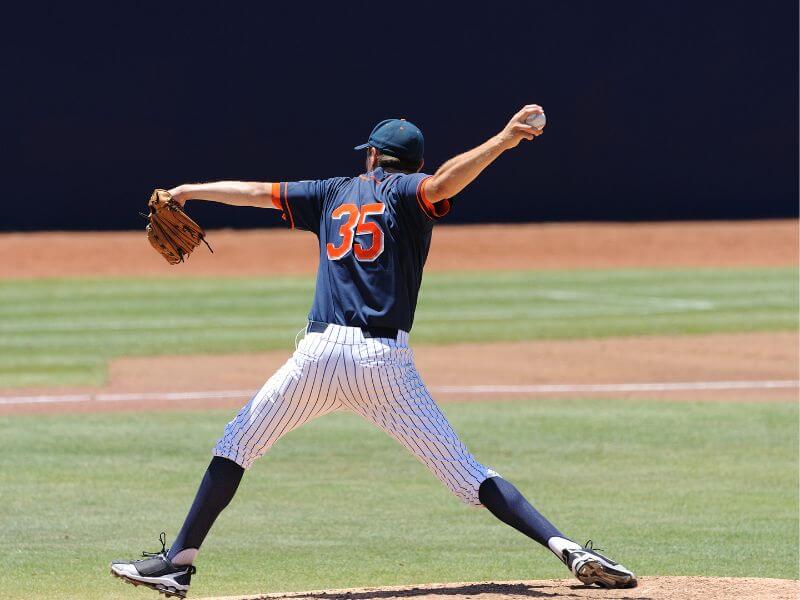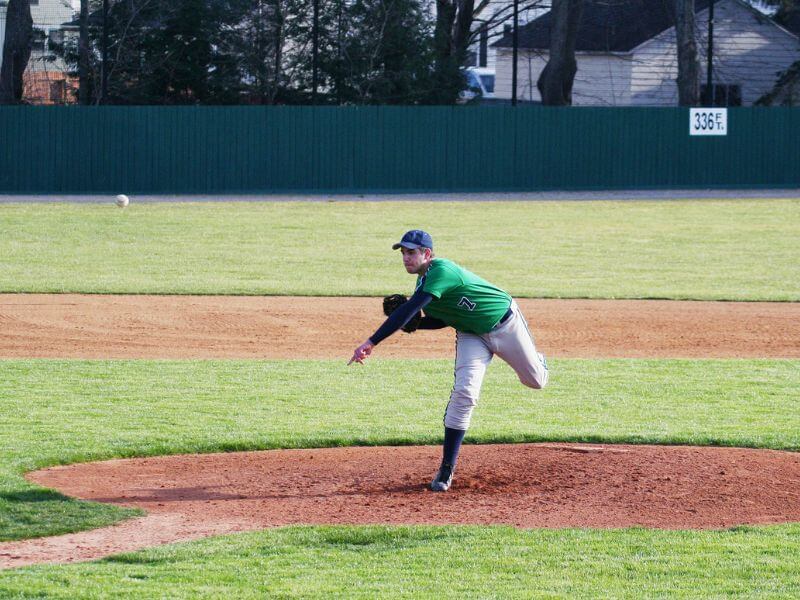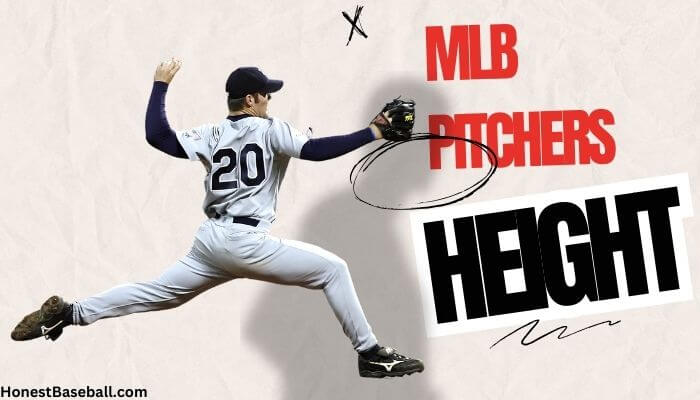It’s fascinating to look into the typical height of an MLB pitcher. This data can shed light on the physiques of major league pitchers and indicate patterns or trends in the game.
Baseball Reference reports an upward trend in pitcher heights in Major League Baseball over the years.
The average height of the MLB Players increased from around 5 feet, 10 inches in 1920 to about 6 feet, 2 inches in 2020.
The increasing heights of MLB pitchers is exciting, but it also raises issues about how much height affects a pitcher’s effectiveness.
Do taller pitchers have a leg up on the competition regarding velocity or command? Or did the strenuous nature of the activity simply cause them to grow taller?
Average Height of an MLB Pitcher
The typical pitcher in Major League Baseball (MLB) is roughly 188 centimeters tall (6 feet 2 inches).
About 189.57 centimeters tall, or 6 feet 2.63 inches, is the average height of a 2023 MLB pitcher.
Pitchers in the early days of Major League Baseball in the 1920s typically stood about 5 feet 10 inches tall.
This standard has risen as the sport itself and methods of training have progressed. The average Major League Baseball pitcher of the 1980s was 6 feet and 1 inch tall, according to the Society for American Baseball Research. (Source: Bleacher Report)
There has been a further rise in the average height during the past two decades. According to current MLB statistics, the typical pitcher is about 6 feet, three inches tall.
Although other elements such as skill, training, and strategy surely play vital roles, this consistent rise over the years suggests that taller pitchers may have an advantage in the sport.
Who Are The Tallest Pitchers in Major League Baseball?
Here is the list of the tallest pitchers in the MLB
| Pitcher | Height | Last Team |
| Loek Van Mil | 7’1″ | Curaçao Neptunus |
| Sean Hjelle | 6’11” | San Francisco Giants |
| Jon Rauch | 6’11” | Miami Marlins |
| Andrew Sisco | 6’10” | Oakland Athletics |
| Eric Hillman | 6’10” | New York Mets |
| Randy Johnson | 6’10” | San Francisco Giants |
| Chris Young | 6’10” | Kansas City Royals |
| Andrew Brackman | 6’10” | Cincinnati Reds |
| Aaron Judge | 6’7″ | New York Yankees |
| Dellin Betances | 6’8″ | New York Mets8 |
Note: Loek Van Mil stands tall as the tallest MLB player in history, measuring an impressive 7 feet 1 inch (approximately 216 centimeters). Hailing from the Netherlands, Van Mil’s towering presence on the pitcher’s mound made him a distinctive figure in the world of baseball.
Who are the Shortest Pitchers in Major League Baseball?
Here is the list of the shortest Pitchers in Major League Baseball.
| Pitcher | Height | Last Team |
| Stubby Magner | 5’3″ | New York Highlanders1 |
| Bobby Shantz | 5’6″ | Philadelphia Phillies2 |
| Yogi Berra | 5’7″ | New York Yankees3 |
| Marcus Stroman | 5’7″ | Chicago Cubs3 |
| Jose Altuve | 5’6″ | Houston Astros4 |
| Whitey Ford | 5’10” | New York Yankees5 |
| Billy Wagner | 5’10” | Atlanta Braves6 |
| Pedro Martinez | 5’11” | Philadelphia Phillies7 |
| Tim Lincecum | 5’11” | Texas Rangers8 |
| Greg Maddux | 6’0″ | Los Angeles Dodgers9 |
Note: Eddie Gaedel holds a unique record in Major League Baseball history. He was the shortest pitcher ever, standing at just 3 feet 7 inches tall (that’s around 109 cm). But here’s the thing: Eddie’s time on the mound was kind of a one-time deal and more of a fun, unusual event than something you’d see regularly in MLB.
Size of MLB Pitchers Throwing an Average Fastball of 98 MPH

The guys in the MLB who are firing off those electrifying fastballs at an average of 98 MPH are typically quite a bit taller than your average Joe. In fact, most of these pitchers tower nearly 6 inches above the height of the average man!
Take a trip back to 2018 with me. The top 10 strikeout kings in the MLB that year had an average height of 6’3 ½” and tipped the scales at around 204 pounds.
Trends in Height for Different Pitching Positions
Regarding pitching positions in baseball, the height of athletes can vary. This variation is often due to the specific requirements of different positions. Let’s explore how the heights of pitchers diverge based on their roles on the pitching mound.
Starting Pitchers
The starting pitchers often stand taller than their counterparts. Their height advantage can contribute to longer strides and higher release points, which can aid in speed and control. The average height of starting pitchers in the MLB is around 6’4”.
Relief Pitchers
Relief pitchers, on the other hand, tend to be a bit shorter. While this is not a strict rule, the average height for relief pitchers is closer to 6’2”. They often rely more on their skill and strategy rather than their physical stature.
Closing Pitchers
Closing pitchers, who are typically called upon to secure the team’s win in the final innings, have an average height similar to the relief pitchers. Their height averages around 6’2” as well. Their role is often more about precision and pressure handling than physical dominance.
Historical Comparison of Pitching Heights Over Time

In the realm of Major League Baseball (MLB), the steady increase in the average height of pitchers over the decades is a well-documented trend. This section will offer a broader perspective on this trend, comparing historical data to present-day statistics.
The Early Years
In the early days of MLB – around the 1920s – the average pitcher’s height was about 5’10”. This was a time when training techniques and nutritional understanding were still developing.
The physical demands of the sport were different, and the players’ profiles mirrored this.
Mid-Century Changes
Moving forward to the mid-20th century, the game saw a significant shift. As training methods and nutrition improved, so did the average height of the pitchers. By the 1980s, the average MLB pitcher had grown to 6’1″.
The Modern Era
In the 21st century, pitcher heights have risen. Current statistics show that the average height of pitchers in the 2023 season is nearly 6’3″.
This historical comparison shows MLB pitchers’ average height changing with the sport. It makes us wonder how MLB will evolve and what direction these trends will take.
The Pros and Cons of Being Taller or Shorter as a Pitcher
Taller pitchers give the impression of throwing faster because they can take longer strides and get the ball to the batter more quickly. Also, batters have a harder time dealing with taller pitchers since they tend to throw the ball higher.
Shorter pitchers also have their advantages. Since their center of gravity is lower, they are easier to steer precisely. Batters often have trouble timing a short, quick-arm pitcher.
Yet taller pitchers run the danger of injury and have difficulty maintaining a regular delivery due to the length of their arm action. It may be difficult for shorter pitchers to get a downward angle on the ball and keep it moving quickly.
Strategies for Players Who Want to Improve Their Performance Regardless of Height
Regardless of height, all pitchers can boost their performance on the mound with the right strategies. Here are some key approaches:
Mastering the Basics
Ensure a solid understanding and execution of the fundamental mechanics of pitching. This includes grip, body positioning, and the proper follow-through. Practicing these basics can improve control and consistency.
Developing a Strong Mental Game
Nurture a strong mental game. Baseball is as much a mental sport as it is physical. Confidence, focus, and the ability to handle pressure are all critical.
Enhancing Physical Fitness
Maintain and elevate your level of physical fitness. Regular strength training and conditioning exercises can help increase your stamina, reduce injury risk, and enhance your overall performance.
Investing in Proper Nutrition
Pay attention to your diet. Proper nutrition fuels the body for optimum performance and aids in recovery after games and practices.
Regular Practice
Consistent and deliberate practice is crucial. This includes working on your strengths and diligently improving your weaknesses. Remember, practice doesn’t make perfect. Perfect practice makes perfect. Here, you will get a guide on Pitching Drills For Accuracy.
FAQs
Are pitchers typically taller than other baseball players?
Yes, pitchers are generally among the tallest players in baseball. For instance, positions like catchers and second basemen usually have lower average heights.
Has the average height of MLB pitchers changed over time?
Pitchers in Major League Baseball have grown taller over time. Pitchers in Major League Baseball typically stood around 5 feet, 10 inches tall in their heyday in the 1920s.
The median height of a person was 6 feet, 1 inch in the middle of the twentieth century.
The average MLB pitcher is now over six feet tall, a trend that has persisted into the modern day. Reasons for this upward tendency include game improvements, training innovations, and dietary enhancements.
Are taller pitchers more successful in baseball?
Longer arms provide taller pitchers a competitive advantage, leading to more effective pitches. Having a tall frame isn’t necessary for success as a pitcher. Ability, forethought, resolve, and tenacity are all required.
There are several excellent pitchers that aren’t particularly tall. Thus, while being tall is advantageous, it is by no means necessary for achievement.
Why are taller pitchers more common now?
Today’s baseball pitchers tend to be taller than in the past for a variety of reasons. To begin with, the game itself appreciates them because of their enhanced ability to throw velocity and deception.
Improvements in sports science and nutrition have led to overall increases in height and strength among competitors across all sports, including baseball.
Moreover, scouts and coaches favor tall pitchers for the perceived advantage they provide. But keep in mind that height is no assurance of success. Skills, intelligence, and tenacity continue to be valued over height in baseball.
Does the average height of MLB pitchers vary by league?
There may be a little but noticeable difference in the average height of pitchers from league to league.
These days, taller pitchers are more common in both the American League (AL) and the National League (NL) of professional baseball. The importance of skill, strategy, and mental toughness cannot be overstated, though, and this holds true in every league.
Can shorter pitchers still be successful in today’s MLB?
Undoubtedly, today’s MLB still offers opportunities for pitchers of shorter height. The game of baseball is one where ability, dedication, strategy, and mental toughness matter more than physical attributes like height and speed.
Proving that height is not the only factor in determining success in baseball, there are many examples of successful MLB pitchers who are not exceptionally tall.
Final Words
success on the mound is not directly proportional to a pitcher’s height, even though being of average height for MLB can have its advantages, such as increased velocity and a steeper downward angle.
Success in baseball is more dependent on talent, planning, mental fortitude, and effort than any other single factor. So, pitchers of any stature may succeed at the highest levels.
Since talent and strategy frequently outshine mere physical traits in baseball, having players of varying heights in the league adds another dimension of complexity and interest to the game.
More Resources
Can Pitchers Fake a Pickoff Attempt
How To Throw A Slider Pitchers Throw
How Do I Stop Being Scared of Fast Pitchers?

Hello everyone. My name is Jason Butler, and I live in California, America. I was a professional AAA Minor League Baseball player. I lost my chance of playing MLB for injury issues, but I did not lose my love for baseball. I attended the coaching training program and am now working as a coach in a small school in San Diego.
I always love to share my experience and knowledge if that can help you. Play baseball, and stay fit.
